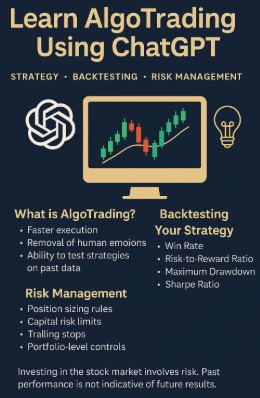In today’s fast-evolving stock market, trading is no longer just about gut feeling and charts. Enter Algorithmic Trading — where technology meets intelligence to automate strategies, speed up execution, and remove emotions from trading decisions.

Now, with tools like Chat GPT, algorithmic trading becomes even more accessible — even for beginners with little to no coding experience. This blog takes you through how Chat GPT can be used to build, back test, and manage risk in trading strategies, all with practical, real-world examples.
💡 What is AlgoTrading?
Algorithmic Trading, or AlgoTrading, is the process of using computer programs to execute trades based on pre-defined rules. These rules can be based on price, volume, time, indicators, or a combination of factors.
The key benefits of AlgoTrading include:
- Faster execution
- Removal of human emotions
- Ability to test strategies on past data
- Consistent and disciplined trading
With the help of AI tools, even retail traders can now create algo strategies without the need for advanced programming skills.
🤖 How ChatGPT Helps Build Trading Strategies
Creating a trading algorithm no longer requires days of coding. With ChatGPT, you can build a strategy by simply describing what you want in plain English.
For example:
“Write a Python code for a strategy that buys when the 20-day moving average crosses above the 50-day moving average.”
ChatGPT can generate:
- Data loading and cleaning scripts
- Entry and exit signals
- Plotting functions to visualize performance
- Stop-loss or trailing stop conditions
This not only saves time but helps traders focus on refining their ideas rather than getting stuck on syntax.
🔁 Backtesting Your Strategy
Backtesting is the process of testing a trading strategy on historical data to see how it would have performed.
Platforms like:
- Backtrader
- QuantConnect
- Pine Script (for TradingView)
can be used for backtesting, and ChatGPT can help you write the logic for them.
When backtesting, focus on:
- Win Rate
- Risk-to-Reward Ratio
- Maximum Drawdown
- Sharpe Ratio
Additionally, ChatGPT can help you run optimizations — for example, testing different stop-loss levels to find the best one historically.
⚠️ Risk Management with AI
Even the best strategy can fail without proper risk management.
With the help of ChatGPT, you can:
- Add position sizing rules
- Limit the capital risk per trade
- Use trailing stops
- Apply portfolio-level risk controls
For instance, simply asking:
“Add 1% capital risk per trade to this strategy in Python.”
ChatGPT will generate code that calculates position sizes based on your total account size and stop-loss distance.
This ensures that one bad trade doesn’t wipe out a large portion of your portfolio.
🧩 Common Mistakes & Pro Tips
Common Mistakes:
- Overfitting: Making a strategy that works only in past data
- Ignoring costs: Not accounting for brokerage, slippage, and taxes
- Overcomplicating: Too many rules make the strategy rigid and hard to execute
Pro Tips:
- Start with simple strategies like moving averages
- Use paper trading or small capital in the beginning
- Continuously learn and improve — ChatGPT is also a great tutor!
🧠 Final Thoughts
AI is transforming the trading landscape. Whether you’re a beginner or a seasoned trader, tools like ChatGPT can supercharge your workflow by helping you generate strategies, analyze results, and manage risk — all while enhancing your understanding of market mechanics.
The real edge lies not in speed alone, but in logic, discipline, and consistency. With the right tools and mindset, anyone can tap into the power of algorithmic trading.
⚠️ Disclaimer
Stock market investments are subject to market risks. The content of this blog is for educational and informational purposes only and does not constitute financial advice. Always do your own research or consult a qualified financial advisor before making any investment decisions. Past performance is not indicative of future results.